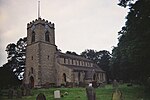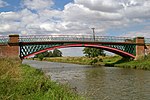Scawby railway station
Disused railway stations in the Borough of North LincolnshireFormer Great Central Railway stationsLincolnshire railway station stubsPages with no open date in Infobox stationRailway stations in Great Britain closed in 1968 ... and 3 more
Railway stations in Great Britain opened in 1849Use British English from May 2017Yorkshire and the Humber railway station stubs

Scawby railway station, also known as Scawby and Hibaldstow railway station, was a station in Scawby, Lincolnshire. It was located on the line between Gainsborough and Grimsby. The station opened in 1849 and closed in 1968 but the line still remains open but calling at fewer stations than it once did.
Excerpt from the Wikipedia article Scawby railway station (License: CC BY-SA 3.0, Authors, Images).Scawby railway station
Station Road,
Geographical coordinates (GPS) Address Nearby Places Show on map
Geographical coordinates (GPS)
| Latitude | Longitude |
|---|---|
| N 53.5218 ° | E -0.5341 ° |
Address
Station Road
DN20 9DW
England, United Kingdom
Open on Google Maps








